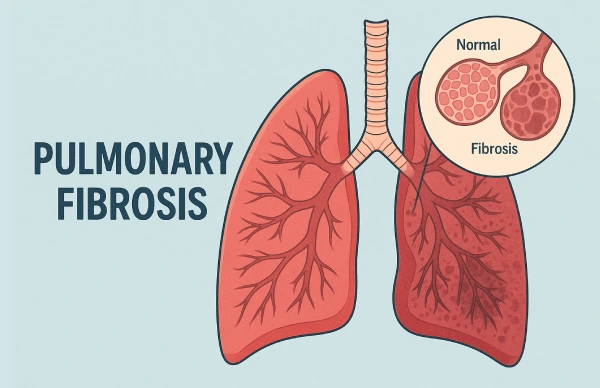Have you ever thought about what it might feel like to fight for every breath, as if your lungs were wrapped in thick, stiff fibers? That’s what living with pulmonary fibrosis can be like.
This lesser-known but serious lung disease causes lung tissue to slowly become scarred and rigid, making it harder to breathe. Although it doesn’t get as much attention as other lung problems, pulmonary fibrosis can greatly affect a person’s daily life. By understanding what it is, what might cause it, the warning signs, who’s more likely to get it, and what treatments are available, patients and their families can take steps toward better lung health. With proper medical help and the right timing, it’s possible to ease symptoms, slow the disease down, and keep living as well as possible.
What Is Pulmonary Fibrosis?
Pulmonary fibrosis is a chronic lung disease that results in thickened, stiff, and scarred lung tissue. This scarring hinders the lungs’ ability to expand and contract normally, making it harder for oxygen to pass through the air sacs and into the bloodstream. Over time, this diminished capacity can lead to breathing difficulties, reduced exercise tolerance, and an overall decline in quality of life
What Causes Pulmonary Fibrosis, and Are There Identifiable Triggers?
Often, the exact cause of pulmonary fibrosis is unclear. When doctors cannot pinpoint a trigger, the condition is termed idiopathic pulmonary fibrosis (IPF). However, several known factors can contribute to developing the disease:
- Environmental exposures: Inhalation of asbestos, silica dust, animal proteins (such as those from bird droppings), or metal dust can damage lung tissue.
- Autoimmune conditions: Disorders like rheumatoid arthritis, scleroderma, and lupus can cause inflammation and scarring of the lungs.
- Medications: Certain drugs used in chemotherapy, heart treatments, and even some antibiotics can increase the risk of lung damage.
- Genetics: In some cases, genetic mutations or a family history of pulmonary fibrosis can increase susceptibility.
What Symptoms Should You Look Out For?
Pulmonary fibrosis often develops slowly, with symptoms that may be subtle at first. Identifying early signs can lead to timely diagnosis and treatment:
- Persistent shortness of breath that worsens over time, especially during activities like walking or climbing stairs.
- A dry, chronic cough that doesn’t improve with conventional treatments.
- Fatigue, weakness, and a general feeling of reduced energy and stamina.
- Unexplained weight loss or loss of appetite.
- Clubbing of the fingers—where fingertips enlarge and nails curve downward.If you notice these signs, seeking medical attention is crucial. Early intervention can help manage symptoms more effectively and slow disease progression.
Who Is at Greater Risk of Developing Pulmonary Fibrosis?
While anyone can develop pulmonary fibrosis, some individuals have an increased risk due to specific factors:
- Age: People over 50 are more commonly affected.
- Occupational exposure: Jobs in mining, farming, or manufacturing, where inhalation of dust and other irritants is common, raise the risk.
- Smoking history: Current and former smokers face an elevated risk.
- Medical history: Those with autoimmune disorders or a family history of pulmonary fibrosis are more susceptible.
What Treatment Options Are Available, and How Can You Manage the Condition?
Although a cure for pulmonary fibrosis remains elusive, various treatments and management strategies exist to enhance quality of life and slow the progression of the disease:
- Medications: Anti-fibrotic drugs can help slow lung scarring, while steroids and other anti-inflammatory medications may ease symptoms.
- Oxygen therapy: Providing supplemental oxygen improves oxygen levels, reducing breathlessness and fatigue.
- Pulmonary rehabilitation: Structured exercise programs, breathing techniques, and education sessions help patients build endurance and learn to manage their symptoms more effectively.
- Lifestyle changes: Quitting smoking, maintaining a balanced diet, and staying physically active can all contribute to better lung health.
- Lung transplant: In severe cases, when other treatments have been exhausted, a lung transplant may be considered to significantly improve quality of life.
Pulmonary fibrosis may be a challenging condition, but understanding it fully—from its causes and symptoms to risk factors and treatments—empowers patients and their families to take proactive steps. Early recognition, timely intervention, and working closely with a skilled specialist can help manage symptoms, maintain better respiratory function, and improve overall well-being.
For personalized guidance and expert care, consider consulting Dr. Parthiv Shah, one of the best pulmonologists in Mumbai. With over 8 years of experience in respiratory medicine, Dr. Shah specializes in managing allergies, asthma, COPD, MDR-TB, pulmonary infections, obstructive sleep apnea, and a wide range of lung diseases. At the Sparsh Super Speciality Lung Clinic, Dr. Shah and his team offer cutting-edge diagnostic tools, advanced therapies, and tailored treatment plans designed to help you breathe easier. Book an appointment today to begin the path toward improved lung health and a better quality of life.

